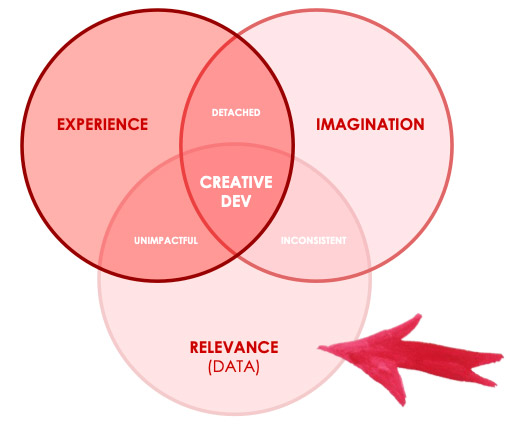The art and science of creativity: three points of view
This is the first article in a three-part series from our Creativity Council on the art and science of creativity.
Over the past five years, there has been a big impact on creative and the creative process due to the exponential availability of marketing data, specifically digital data. This has arguably created some tension between agency and client as well as creatives and data planning specialists. The issue has been about points of control in the production of the creative and more importantly, what goes to market and what happens after it is in-market.
This three-part blog series looks to examine the art and science of creativity, from the points of view of the client, the agency, and the data science specialist. While there are obvious divergences in the application and role of data, there is some clear common ground, which sets the foundation for a successful model of data integration into creative development.
In addition to these three points of view, this series of articles is further divided into three questions, each addressed separately by the individual contributors. Every piece and the opinions contained within them is the result of a collaboration between three marketing professionals and members of the CMA’s Creativity Council, with insight provided from the perspective of the client, the research expert and the creative agency.
Rooted in research
To have a foundation based on data, members of the Canadian Marketing Association as well as colleagues of the contributors, were polled on a number of topics surrounding the subject matter. The answers were varied at times, but there was a general consensus indicating a rational favourability for the usage of data at the right time and in the right place. Overall, respondents felt that data was very valuable as an input to inform creative, but that it shouldn’t necessarily drive it.
Balance
We start off with a question around the matter of balance: Do you agree that you need the science to balance the art, otherwise the results are subjective?
The agency: Yes. Agency creative must solve a business challenge.
A good agency partner is there to help solve a business challenge. Great creative for the sake of great creative will only win awards. Creative development aimed at a client’s success should be approached with the right mix of experience, imagination and relevance. Relevance is driven by data, be it anecdotal, quantitative or qualitative. Without data to inform experience and imagination, the end result often falls short.
Experience and imagination can produce creative that is detached from the end goal or the target audience, falling short of bringing a brand closer to its target audience. At the same time, data alone can’t pull the weight of experience or imagination. Data and experience without imagination lacks impact, and data and imagination without experience breeds inconsistency.
The right approach towards solving a business challenge is a blending of experience and imagination with data – relevance – drawn in at the correct time in the creative development process.

The research expert: Insights are the springboard for objective creativity.
Gone are the days of choosing a creative direction based on a gut-reaction. Now, with the surplus of datasets available to marketers, making marketing decisions with less bias and tailoring the creative to the target markets’ interest is closer than it has ever been before.
Data innovation anchored in personalization is a standard expectation from consumers, and it’s been proven that creative personalization performs while in-market:
- Marketing firms that exceed revenue goals apply personalization 83 per cent of the time.
- “Businesses that use data-driven personalization recorded between five and eight times the return on investment (ROI) on their marketing budgets.”
- Consumers crave a personalized advertising experience and 2016 research found that 71 per cent of respondents prefer ads tailored to their interests and shopping habits.
Data shouldn’t be viewed as a limitation to creative thought; creatives can conduct outside of the box thinking while inside of certain parameters which are outlined by datasets.
A great example of utilizing a data-driven approach to creative development was the 2019 Super Bowl commercial for Olay by Saatchi & Saatchi. The team looked at datasets from Google and YouTube to learn more about their audience’s interests outside of skincare and found two core areas of interest that stood out – horror movies and football. This led to the development of the #KillerSkin campaign, a tongue-in-cheek nod to all three interests of their target market. The ad featured actors, Sarah Michelle Gellar and Freddie Prinze Jr. who were nostalgic figures of horror movies for the target market. The campaign successfully generated millions of views and a huge spike in search interest for the brand.
The client: There is no question about it. Creative is subjective.
Creative campaigns are developed to address a business problem or opportunity. The client creates a brief providing the creative agency with insights and proof points that are unique and marketable. The agency uses those insights to generate big idea concepts. Great creative breaks through the clutter and has an emotional connection with the target audience. Success is measured with an increase in awareness, consideration and client acquisition. For the client, the Holy Grail is to generate a positive and efficient ROI.
At one time, the client based their rational for liking or not liking creative concepts on a gut reaction. It resonated with them or their management team.
With the advent of creative research testing in a lab environment, some objectivity based on science was introduced to the decision-making process. Creative ideas could be tested with a target audience before going in-market. The research agency provided in-depth analysis of the consumers’ reactions to the creative. Creative agencies dreaded this client need to have objective facts about the creative because the client would often use these insights to tweak the concept and sometimes kill the creative before taking it to market.
In the past five years, digital data has exploded and now creative can be data-driven once in-market. The client has access to digital campaign data and campaign optimization through the application of algorithms and machine learning. This allows the stronger in-market creative concepts to rise to the top. As well, we can now do effective A/B testing and optimize creative in real time.
The client can make decisions to optimize the campaign and measure results, however there is a problem. While we have brought objectivity to creative concepts, we have lost the reason why. We don’t know why consumers choose one creative concept or version over another, or do not choose any at all. Data does not measure the reason why.
Stay tuned for two more blogs in this series on the art and science of creativity.
Authors:
Julia Clements, Digital Market Research Professor, School of Business, Seneca College
Lauragaye Jackson, Director of International Banking Marketing, RBC
Alex Shifrin, President, LP/AD



































